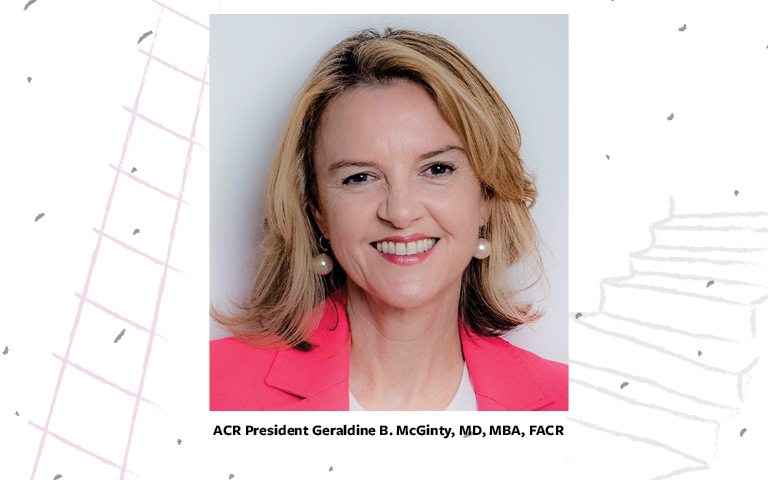Reducing health disparities has long been on medicine’s radar, but COVID-19 has put a brighter light on how structural inequities directly impact access and outcomes for a wide swath of patients. Until recently, there has been relatively little focus on the issue when it comes to radiology — but radiologists have a significant role to play.
The Bulletin spoke with ACR President Geraldine B. McGinty, MD, MBA, FACR, about the College’s plan to convene the Radiology Health Equity Coalition to drive imaging equality across healthcare. The coalition, which will be championed by BOC Vice Chair Jacqueline A. Bello, MD, FACR, will be formally announced by McGinty during her presidential address at ACR 2021 in May.
What was the impetus for the ACR forming the coalition?
As we looked at the disparities highlighted by the pandemic, as well as some of the social justice protests of the last year, we realized that we needed to more actively leverage the unique opportunities that radiology has to make a difference in health equity. The ACR’s history of concretely demonstrating and ensuring the value of high-quality imaging care across stakeholders is well-established. Focusing all aspects of imaging on improving access to care, identifying missed care opportunities at the community level, and reducing imaging outcomes variability has the potential to reap benefits across the continuum of care and position radiologists as stewards of population health management (learn more in the population health management recorded webinar, “Understanding and Pursuing Health Equity: Opportunities to Take Action,” at acr.org/PHM).
What are some of the outcomes disparities that the coalition will address?
The coalition will address well-documented outcomes disparities such as higher cancer deaths for underserved populations (due to reduced access to screening and screening recommendations based on flawed data); variations in care based on race and ethnicity, as well as rurality and zip code; and documented discrepancies in life expectancy and outcomes that could be affected by access to imaging care. Lung cancer screening presents a significant opportunity because we know we’re not screening nearly enough people. There is a specific opportunity in communities of color, where the impact of lung cancer is higher and where we’re not necessarily reaching patients the way we should.
The representative and collaborative nature of the ACR offers a place for all perspectives, while retaining the core of healthcare professionals’ desire to care for all members of their communities of practice, regardless of their ability to pay, as noted in the FACR pledge. To me, that transcends any political leanings.
Who are some of the stakeholder organizations that the ACR will partner with?
I foresee every radiologist and every radiology organization playing a part in ensuring that all our patients have access to high-value imaging care. Radiology specialty societies have a track record of cooperation and rapid changemaking when the stakes are high. Our patients are facing pressing issues that can only be solved by a unified and full-strength effort across the radiology community. By building on the expertise that each of our sister societies brings to the challenge of health disparities, we will magnify our effect to make measurable impact and change the current imaging inequities.
We also plan to work with our organized medicine conveners like the AMA and the American Hospital Association to get input from their experiences and experts. I want to be clear that the ACR doesn’t want to own this coalition — we want to work across the entire profession of medicine as we try to influence policy. We want to bring everyone together around a shared set of goals.
How can ACR members get involved with the coalition?
As the April 2019 issue of the JACR® demonstrates, there are opportunities for all radiologists to drive high-value imaging care for all Americans (read more at jacr.org). The ACR is committed to having opportunities for our members to volunteer in health equity efforts. At the chapter level, there are state chapters with diversity committees — that is a great way to get involved in making our radiology workforce more diverse. There are other issues that come up, such as renewal of the protections for coverage for mammography screening — and every ACR member can be involved by asking their elected representative in Congress to support that effort.
Do you anticipate the current divisions in American politics to affect the work of the coalition?
The representative and collaborative nature of the ACR offers a place for all perspectives, while retaining the core of healthcare professionals’ desire to care for all members of their communities of practice, regardless of their ability to pay, as noted in the FACR pledge. To me, that transcends any political leanings. We may all have different ideas on how to effect change but that healthy exchange of ideas is exactly what we’re hoping to get from this coalition.

